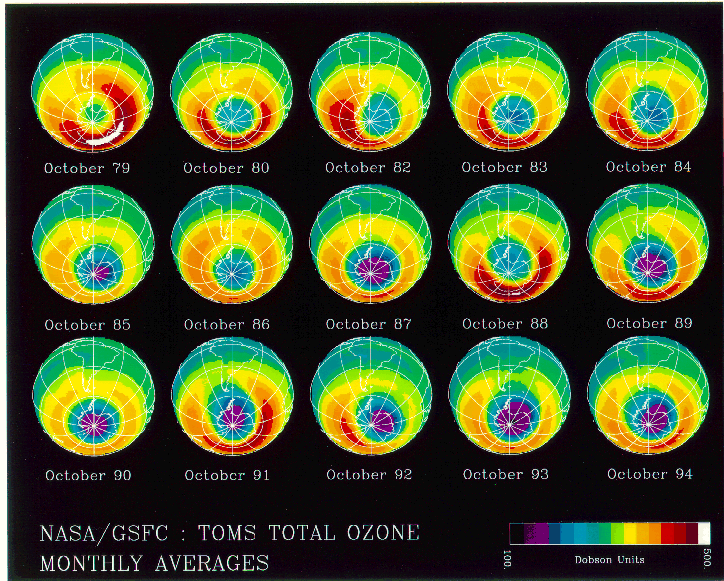
|

The progressive of deepening of the hole in the Earth's protective ozone shield. Courtesy of NASA.
Stratospheric Chemistry and Climate
Traditionally, studies in the stratosphere using column ozone amount, ozone profiles, and dynamical variables at midlatitudes have centered on zonal averages of these quantities made over specific latitude bands. This is in sharp contrast to the studies made within the polar vortices where the average is made within regions defined by potential vorticity, a meteorological parameter. An analysis of the ozone field in the Northern Hemisphere outside of the polar vortex is presented in which it is shown that this field can also be separated into meteorological regimes. These regimes are defined as 1) the tropical regime, between the equator and the subtropical front; 2) the midlatitude regime, between the subtropical and polar fronts; 3) the polar regime, between the polar front and the polar vortex; and 4) the arctic regime, within the polar vortex. Within each regime the zonal daily mean total ozone value is relatively constant, with a clearly separate value for each regime. At the same time, the stratospheric ozone profiles are clearly distinguishable between regimes, each regime having a unique tropopause height. A midlatitude zonal average, whether of ozone profiles, total ozone, or dynamical variables, will depend on the relative mix of the respective values within each regime over the latitude range of the average. Because each regime has its own distinctive characteristic, these averages may not have physical significance.- Hudson RD, Frolov AD, Andrade MF, et al. The total ozone field separated into meteorological regimes. Part I: defining the regimes JOURNAL OF THE ATMOSPHERIC SCIENCES 60 (14): 1669-1677 JUL 2003.
Stratospheric ozone Chemistry
Words from Ross & Tim............
- Kovalenko LJ, Jucks KW, Salawitch RJ, et al. Observed and modeled HOCl profiles in the midlatitude stratosphere: Implication for ozone loss GEOPHYSICAL RESEARCH LETTERS 34 (19): Art. No. L19801 OCT 2 2007.
- Salawitch RJ Why is there an ozone hole in the atmosphere when there is too much ozone at ground level? SCIENTIFIC AMERICAN 297 (2): 102-102 AUG 2007